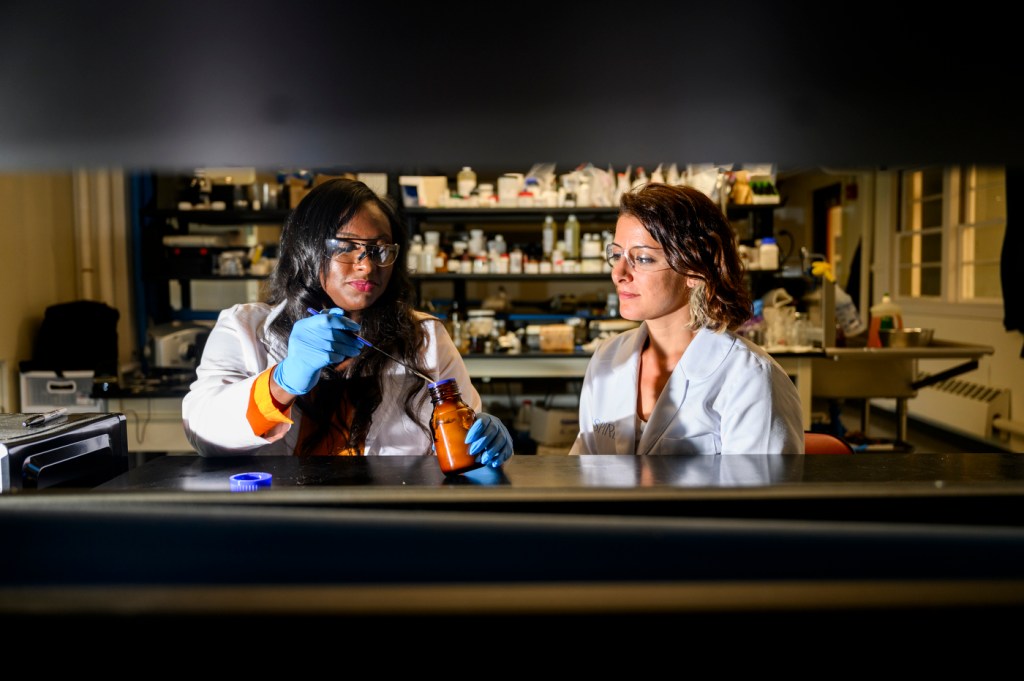Octopus and squid pigments enhance sunscreen without harming the environment, Northeastern researchers and company founders say

When Northeastern graduate Camille Martin and associate professor Leila Deravi co-founded Seaspire, a skincare ingredients company inspired by pigment in octopus and squid, their goal was to create a product that is good for your skin and the environment.
New research shows that they are on the right track.
A paper published in the International Journal of Cosmetic Science says that Xanthochrome, a synthesized version of a molecule found in cephalopods such as squid, octopus and cuttlefish, boosts levels of sunscreen protection in combination with zinc oxide while having no adverse effects on coral cuttings.
The marine safety findings are important because “there’s a lot of toxicities involved with (traditional) UV filters in sunscreens,” says Deravi, who is Seaspire’s scientific adviser and an associate professor of chemistry and chemical biology.



“Some of the chemical UV-filters in particular are known to create reactive oxygen species that are not only bad for the environment but can also seep into our skin and cause systemic toxicities,” she says.
The result is a pressing need for environmentally friendly ingredients, says Martin, who got her Ph.D. in chemistry from Northeastern in 2019 and has served as Seaspire’s CEO since its founding that year.
“The industry is really excited about new materials innovations,” she says. “Everything we do as a biotechnology company is centered around leveraging marine animals as a source of inspiration for the next generation of skin care ingredients.”
From Northeastern chemistry lab to market
The goal of Seaspire, Martin says, is to make Xanthochrome available to skin care product manufacturers and distributors up and down the supply chain so that it ends up in a wide range of skin care and personal care products including sunscreens, anti-aging applications and functional color cosmetics.
“We are just wrapping up the research and development on it now and actively looking for partnerships to bring this to market,” Deravi says.
Produced as a brown, textured powder, Xanthochrome has potent antioxidant and skin restorative properties as well as having light scattering qualities that provide protection against photoaging, Martin and Deravi say.




Martin says Xanthochrome is the trade name for a chemically synthesized version of xanthommatin, which is found in the skin of cuttlefish, octopus and squid and in insects as well.
“The secret to the cephalopods’ unique coloration is derived from its multifunctional chemical compounds, which we identified in our lab at Northeastern,” Deravi says.
“Camille’s Ph.D. work was the first to show that these small molecules inside cephalopod skin that contribute to camouflage in the animal also have really interesting antioxidant properties,” Deravi says.
“They’re free radical scavengers, which are very important for skin health and skin barrier function,” she says.
“And then they also have pretty important optical properties protecting against exposure to sunlight, which is the main function of some UV filters and sunscreens,” Deravi says.
“We didn’t create a new molecule,” Martin says. “We were able to isolate and characterize the properties of the biomolecules found within cephalopods, engineer a bio-identical version of the naturally occurring material and position Xanthochrome as a new active ingredient that provides a wide range of skin care benefits.”
“It’s a really interesting space where you have a single molecule that can have so many functions,” she says.
Previous research showed Xanthochrome, unlike the parabens that often go into sunscreens, is not an endocrine disruptor.
The most recent study shows that it boosts the ultraviolet protection of zinc oxide, which the U.S. Food and Drug Administration considers a safe and effective ingredient in sunscreen, by 28% and the blocking potential of visible light by 45%.
It also showed Xanthochrome did not have an adverse effect on coral cuttings even at concentrations five times higher than what are used in typical formulations.
Martin and Deravi hope that skincare product manufacturers see Xanthochrome as a next-generation ingredient on the heels of retinoids and vitamin C and hyaluronic acid.
“We’re creating products that can really be applied and adopted across a wide range of users,” Martin says. “We are creating something that is not only safe for all people, but also the environment.”
“You have to prove the new raw materials are safe for humans and also for the ocean, where ultimately every product is going to get washed into,” Deravi says.






